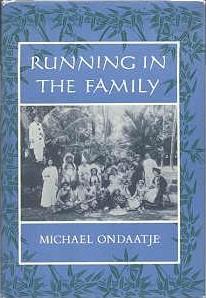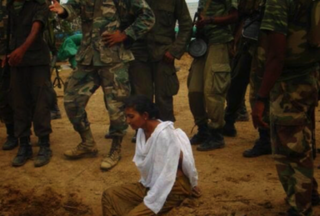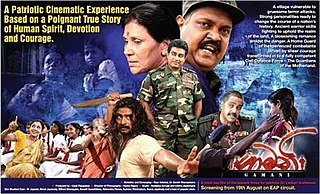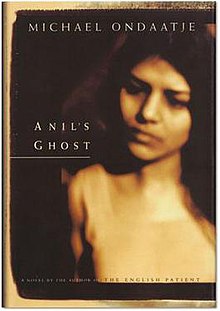
Philip Michael Ondaatje is a Sri Lankan-born Canadian poet, fiction writer, essayist, novelist, editor, and filmmaker.
Capital punishment is a legal penalty in Sri Lanka.

Richard Manik de Zoysa was a well-known Sri Lankan journalist, author, human rights activist and actor, who was abducted and murdered on 18 February 1990. His murder caused widespread outrage inside the country and is widely believed to have been carried out by a death squad linked to elements within the government.

Running in the Family is a fictionalized memoir, written in post-modern style involving aspects of magic realism, by Michael Ondaatje. It deals with his return to his native island of Sri Lanka, also called Ceylon, in the late 1970s.
Ida Carmelitta or Farheen Ida Carmelitta Laila Figerardo was a minority Sri Lankan Tamil woman who was gang raped and killed on 12 July 1999 and became a cause célèbre of the Sri Lankan civil war.

Sarathambal Saravanbavananthatkurukal or better known as Sarathambal was a minority Sri Lankan Tamil woman who was gang raped and killed on 28 December 1999. This became an internationally known incident of the Sri Lankan Civil War.

Admiral of the Fleet Wasantha Kumar Jayadeva Karannagoda, RSP, VSV, USP, MRIN, MNI is a Sri Lankan naval officer. He served as the Commander of the Sri Lankan Navy during the last phase of the Sri Lankan Civil War and Governor of North Western Province, Sri Lanka from 2021 to 2023.
Pandukabhaya was a king of Upatissa Nuwara and the first monarch of the Anuradhapura Kingdom and 6th over all of the island of Sri Lanka since the arrival of the Vijaya; he reigned from 437 BC to 367 BC. According to many historians and philosophers, he is the first truly Sri Lankan king since the Vijayan migration, and also the king who ended the conflict between the Sinha clan and the local clans, reorganising the population.
The Sunday Leader was an English-language Sri Lankan weekly newspaper published by Leader Publications (Private) Limited. It was founded in 1994 and is published from Colombo. Its sister newspapers are the Iruresa (Irudina) and the defunct The Morning Leader. Founded by brothers Lasantha Wickrematunge and Lal Wickrematunge, the newspaper is known for its outspoken and controversial news coverage. The newspaper and its staff have been attacked and threatened several times and its founding editor Lasantha Wickrematunge was assassinated.
Sergeant Yakandawala Liyanarachchige Chaminda Ruwan Yakandawala was a Sri Lankan soldier. A member of the Sri Lanka Army Military Police he was selected to serve in the Security Division of the Commander of the Sri Lanka Army, Sarath Fonseka. On April 25, 2006, he blocked the path of a Tamil Tiger suicide bomber tasked with assassinating Fonseka. Unable to proceed, the suicide bomber detonated the explosives strapped around her waist, killing Yakandawala and eight others in the process. Yakandawala's quick actions however saved the life of Sarath Fonseka, who would go on to play a crucial role in the ultimate defeat of the Tamil Tigers and the ending of the Sri Lankan Civil War.

Baminnahennadige Dinakshie Priyasad is a Sri Lankan actress and television presenter. Priyasad made her acting debut at the age of two in the film Apaye Thathpara 84,000 directed by her father Dinesh Priyasad.
Shayama Ananda, popularly known as Shayama Ananda, is an actress in Sri Lankan Sinhala cinema.
Wimal Kumara de Costa was an actor in Sri Lankan cinema. One of the most popular comedy artists in 1980s and 1990s, he started cinema career with character roles in art films where he later moved to comedy roles in cinema. He is cited as the pioneer of Sri Lanka mime industry.

Shoba, also known as Shobana Dharmaraja, was a Sri Lankan Tamil journalist and television broadcaster for the rebel Liberation Tigers of Tamil Eelam (LTTE). She died in the final days of the Sri Lankan Civil War in 2009 with video evidence that she was captured by the Sri Lankan military before being raped, tortured and murdered. A senior United Nations official deemed the footage to be authentic. Amnesty International and Human Rights Watch also verified that it was her.
Varuni Amunugama Fernando is a Sri Lankan businesswoman and a prominent figure in the country’s advertising industry. She founded Triad Advertising (Pvt) Limited and the national TV channel Derana.

Maya is a 2016 Sri Lankan Sinhala 3D horror comedy film directed by Donald Jayantha and co-produced by Raja Sadesh Kumar and Srimathi Sadesh Kumar. It stars Ranjan Ramanayake, Pubudu Chathuranga in lead roles along with Giriraj Kaushalya, Nilmini Kottegoda and Upeksha Swarnamali. It is the 1257th Sri Lankan film in the Sinhala cinema. The film is based on Indian Tamil film Kanchana directed by Raghava Lawrence.

Gamani is a 2011 Sri Lankan Sinhala war thriller biographical film directed by Rear Admiral Sarath Weerasekara and produced by Upali Rajapakse. It stars Dilhani Ekanayake and Bimal Jayakody in lead roles along with Mahendra Perera and Jagath Chamila. Music composed by Nadeeka Guruge. It is the 1245th film in Sri Lankan cinema.
Sudu Hansi is a 2010 Sri Lankan Sinhala adult drama film directed by Mohamad Shaffraz and co-produced by Sisira Hewahenna and Chandrika Godakanda for Nimana Films. It stars Arjuna Kamalanath, Amisha Kavindi and Semini Iddamalgoda in lead roles along with Muthu Tharanga and Sarath Chandrasiri. Music composed by Navaratne Gamage. It is the 1133rd Sri Lankan film in the Sinhala cinema.
Sexual violence against Tamils in Sri Lanka has occurred repeatedly during the island's long ethnic conflict. The first instances of rape of Tamil women by Sinhalese mobs were documented during the 1958 anti-Tamil pogrom. This continued in the 1960s with the deployment of the Sri Lankan Army in Jaffna, who were reported to have molested and occasionally raped Tamil women.

Vijaya Kumaratunga, Sri Lankan politician and founder of the Sri Lanka Mahajana Pakshaya, was assassinated by an assassin of the militant organization Deshapremi Janatha Viyaparaya (DJV) on February 16, 1988, while attempting to leave his home in Polhengoda in Colombo.










